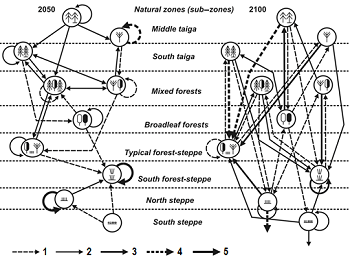Predictive Assessments of the Impact of Modern Global Warming on the Landscape-Zonal Conditions of the Volga River Basin
Main Article Content
Abstract
Prognostic landscape-ecological scenarios for the near future of the biosphere have been considered for the first time by taking a large region--the Volga River basin--as an example. The analysis was based on a method of regional landscape-ecological prognosis--developed by the author using discrete mathematics methods. Analytical and cartographic models of future landscape-ecological conditions (for 2050, 2075, and 2100) were obtained. The mechanisms of shifts in the mosaic structure of vegetation, soils, and landscapes have been revealed in the study area under different disturbance scenarios of the climatic system--scenarios anticipated in the foreseeable future (by the end of the 21st century). Forthcoming anthropogenic warming, accompanied by an excessive increase in surface runoff, will occur at the expense of a relative decrease in evapotranspiration, and particularly in groundwater flow. A progressively intensifying thermo-arid bioclimatic trend is predicted, with a general northward shift of zonal boundaries and corresponding changes in the soil water regime and vegetation cover structure. The prognostic models show the convergence of phytocoenoses into new zonal vegetation types.
Article Details

This work is licensed under a Creative Commons Attribution-NonCommercial 4.0 International License.
References
- Budyko MI. Climate in the past and in the future. Leningrad: Gidrometeoizdat; 1980 (in Russian).
- Budyko MI, Borzenkova II, Menzhulin GV, Selyakov KI. Forthcoming changes in the regional climate. Izvestiya RAN. Ser. geogr. 1992;4:36-53 (in Russian).
- Houghton LG, Meira Filho LG, Callander BA, et al, eds. Climate Change 1995: The Science of Climatic Change. Cambridge, UK: Cambridge University Press; 1996.
- Izrael YuA, ed. Estimates of the Environmental and Socio-Economic Impacts of Climate Change: IPCC Working Group II Report. Sankt Petersburg: Gidrometeoizdat; 1992 (in Russian).
- Kondratyev KYa, Losev KS, Ananicheva MD, Chesnokova IV. Estestvenno-naychnye osnovy ustoychivosti zhizni. Moscow: VINITI, Inst. Geographii RAN; 2003 (in Russian).
- Bazilevich NI, Grebenshchikov OS, Tishkov AA. Geographic patterns of the structure and functioning of ecosystems. Moscow: Nauka; 1986 (in Russian).
- Kolomyts EG. Regional Model of Global Environmental Changes. Moscow: Nauka; 2003 (in Russian).
- Sukachev VN. Selected Works. Vol 1: Basics of Forest Typology and Biogeocoenology. Leningrad: Nauka; 1972 (in Russian).
- Armand AD, Targul’an VO. Some fundamental limitations of experiment and modeling in geography. Izvestiya Acad. Nauk SSSR. Ser. geogr. 1974;4:129-138 (in Russian).
- Sukachev VN. Selected Works. Vol 3: Phytocoenology Problems. Leningrad: Nauka; 1975 (in Russian).
- Sochava VB. Vegetation Cover on the Subject Maps. Novosibirsk: Nauka; 1979 (in Russian).
- Budyko MI. Global Ecology. Moscow: Mysl’; 1977 (in Russian).
- Grigor’ev AA. Regularities of the structure and development of the geographic environment. Moscow: Mysl’; 1966 (in Russian).
- Isachenko AG. Landscapes of the USSR. Leningrad: Publishing House of Leningrad State University; 1985 (in Russian).
- Izrael YuA, ed. Condition and Comprehensive Monitoring of the Natural Environment and Climate: Limits of Change. Moscow: Nauka; 2001 (in Russian).
- Kislov AV. Changes and variability of the global climate. In: Modern Global Changes in the Natural Environment. Vol 1. Moscow: Nauchny Mir; 2006:118-129 (in Russian).
- Kobak KI, Kondrasheva NYu. Global warming and natural zones. Meteorology and Hydrology. 1992;8:91-98 (in Russian).
- Kobak KI, Kondrasheva NYu, Turchinovich IE. Impact of climate change on natural zonality and Russian ecosystems. In: Climate Changes and Their Consequences. St Petersburg: Nauka; 2002:205-210 (in Russian).
- Albritton DL, Barker T, Bashmakov I, et al. Changing of the climate. In: Whotson RT, ed. Synthesis Report MGEIK. Geneva: World Meteorological Organization; 2003 (in Russian).
- Kolomyts EG. Boreal Ecotone and Geographic Zonality: Atlas-Monograph. Moscow: Nauka; 2005 (in Russian; abstract in English: 380-384).
- Gribova SF, Isachenko TI, Lavrenko EM, eds. Vegetation of the European part of the USSR. Leningrad: Nauka; 1980 (in Russian).
- Kustler G. ABC of information theory. In: Yockey HP, ed. Information Theory in Biology. London: Pergamon Press; 1957:5-48.
- Leemans R. Modelling ecological and agricultural impacts of global change on a global scale. J Sci Ind Res. 1992;51:709-724.
- Odeh IOA, Chittleborough DJ, McBratney AB. Fuzzy‐c‐Means and Kriging for Mapping Soil as a Continuous System. Soil Science Society of America Journal. 1992, 56(6): 1848-1854. https://doi.org/10.2136/sssaj1992.03615995005600060033x
- Odum EP. Fundamentals of Ecology. 3rd edn. Philadelphia, PA: W.B. Saunders Company; 1971.
- Puzachenko YuG, Skulkin VS. Structure of Forest Zone Vegetation for USSR: System Analysis. Moscow: Nauka; 1981 (in Russian).
- Rauner YuL. Thermal Balance of Vegetation Cover. Leningrad: Gidrometeoizdat; 1972 (in Russian).
- Santer B. The use of general circulation models in climate impact analysis? A preliminary study of the impacts of a CO2-induced climatic change on West European agriculture. Climatic Change. 1985, 7(1): 71-93. https://doi.org/10.1007/bf00139442
- Andreev VL. Classification Constructs in Ecology and Systematics. Moscow: Nauka; 1980 (in Russian).
- Smith TM, Shugart HH. The transient response of terrestrial carbon storage to a perturbed climate. Nature. 1993, 361(6412): 523-526. https://doi.org/10.1038/361523a0
- Sudnitsin II, Sidorova MM, Oreshkin NS, Vasilyeva MI. Influence of meteorological conditions on changes in moisture reserves in soddy-podzolic soil. Meteorology and Hydrology. 1988;8:90-99 (in Russian).
- Velichko AA, ed. Climates and Landscapes of Northern Eurasia in the Context of Global Warming: Retrospective Analysis and Scenarios. Moscow: GEOS; 2010 (in Russian).
- Verigo SA, Razumova LA. Soil Moisture (in Relation to Agricultural Needs). Leningrad: Gydrometeoizdat; 1973 (in Russian).
- Volobuev VR. Soil System of the World. Baku: Elm; 1973 (in Russian).
- Wetherald RT, Manabe S. The Mechanisms of Summer Dryness Induced by Greenhouse Warming. Journal of Climate. 1995, 8(12): 3096-3108. https://doi.org/10.1175/1520-0442(1995)008<3096:tmosdi>2.0.co,2



